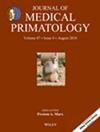作为动物研究模型的猫头鹰猴。第3部分:研究使用和疾病
IF 0.5
4区 农林科学
Q3 VETERINARY SCIENCES
引用次数: 0
摘要
鸮猴是唯一的夜行猿类灵长类动物,因此,它们与其他非人类灵长类动物非常不同。50多年来,猫头鹰猴一直被用作疟疾研究的动物模型;然而,它们也是研究广泛的传染性疾病和一些非传染性疾病的有用模型。此外,猫头鹰猴会自发地受到各种细菌、病毒、真菌和寄生虫疾病的影响,其中一些具有人畜共患的潜力,在生物医学研究中使用猫头鹰猴属时需要考虑到这一点。本文就该属植物的研究、利用及自然发病作一综述。本文章由计算机程序翻译,如有差异,请以英文原文为准。
The Owl Monkey (Aotus spp.) as an Animal Research Model. Part 3: Research Use and Diseases
Owl monkeys (Aotus spp.) are the only nocturnal simian primates and, as such, they are very different from other nonhuman primate species. Owl monkeys have been used as animal models in malaria research for over 50 years; however, they are also useful models to study a wide range of infectious and some noninfectious diseases. In addition, owl monkeys are spontaneously affected by a wide range of bacterial, viral, mycotic, and parasitic diseases, some of them with zoonotic potential that need to be considered when using this genus in biomedical research. Here we briefly review the research use and spontaneous diseases of this unique genus.
求助全文
通过发布文献求助,成功后即可免费获取论文全文。
去求助
来源期刊
CiteScore
1.40
自引率
42.90%
发文量
62
审稿时长
6 months
期刊介绍:
The Journal of Medical Primatology publishes research on non-human primates as models to study, prevent, and/or treat human diseases; subjects include veterinary medicine; morphology, physiology, reproductive biology, central nervous system, and cardiovascular diseases; husbandry, handling, experimental methodology, and management of non-human primate colonies and laboratories; non-human primate wildlife management; and behaviour and sociology as related to medical conditions and captive non-human primate needs.
Published material includes: Original Manuscripts - research results; Case Reports - scientific documentation of a single clinical study; Short Papers - case histories, methodologies, and techniques of particular interest; Letters to the Editor - opinions, controversies and sporadic scientific observations; Perspectives – opinion piece about existing research on a particular topic; Minireviews – a concise review of existing literature; Book Reviews by invitation; Special Issues containing selected papers from specialized meetings; and Editorials and memoriams authored by the Editor-in-Chief.

 求助内容:
求助内容: 应助结果提醒方式:
应助结果提醒方式:


